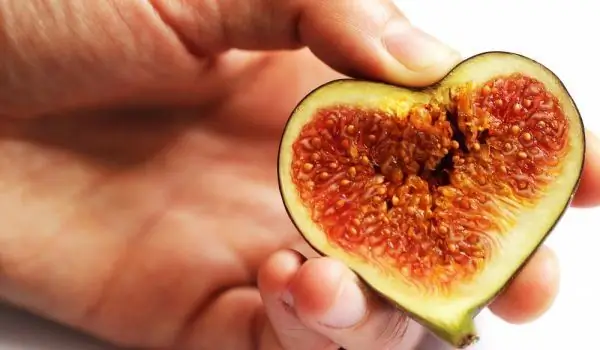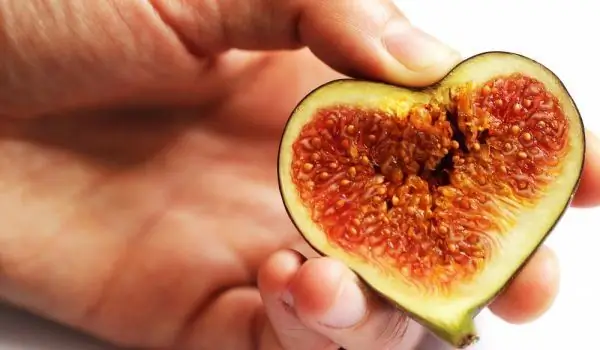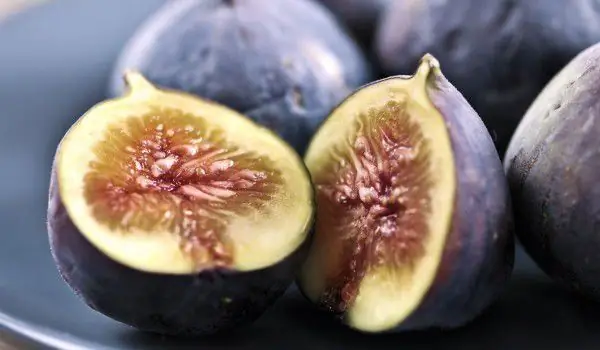2025 Author: Jasmine Walkman | [email protected]. Last modified: 2025-01-23 10:18
Figs are the fruits of the fig tree, which grows in tropical, subtropical and less frequently in temperate climates. The tree reaches 3 to 10 meters in height, its leaves are large, and the fruits have the shape of small bags with dimensions of 3 to 5 cm.
History of figs
Evidence for the existence of figs has been found in excavations in Neolithic areas dating back to around 5000 BC. Ancient Greek civilizations highly valued figs and knew almost 29 varieties of them. Legend has it that the fig tree is an autumn fruit that was discovered by the Greek goddess Demeter and the fig tree is still considered sacred in many parts of the Mediterranean. The Romans believed that figs were donated by Bacchus, the God of wine, and he was almost always depicted with a crown of fig leaves.
Originating in West Asia, figs have been distributed in the Mediterranean region through human migration. Over time, their cultivation spread to Western and Central Europe, in areas stretching between Afghanistan in Asia to Germany and even the Canary Islands. In the middle of the fifteenth century, figs were brought to England, and since then fig trees have grown in the gardens of wealthy households in China. The European variety figs is shipped to India, Japan, South Africa and even Australia. In the New World, they were transported in 1560, but reached the United States in 1699 when the first figs are planted in Virginia.
Figs were probably one of the first fruits to be dried and stored. In ancient Greece, figs were considered a valuable and sacred fruit and their export was banned.

Mithridates, the Greek king of Pontus, declared figs a cure for all diseases and it was obligatory for all his subjects to eat figs daily. To honor them, figs were awarded to the winners of the Greek Olympics. The fact that the ancient Greeks and Romans revered figs is extremely proven by the widespread belief that figs are stores of useful nutrients and can be used to treat almost all known diseases. Figs were the favorite fruits of Cleopatra.
Composition of figs
The content of vitamins in figs is very small, but on the other hand they have a very rich mineral composition. They contain potassium, calcium, sodium, iron, magnesium, phosphorus. However, figs have a moderate dose of vitamins - K, B1 and B6. Figs have the highest fiber content among all fruits and vegetables. Just one fig provides 20% of the recommended dose of fiber per day.
In 100 g of fresh figs contains 25 calories, and 100 g of dried figs have 100 calories.
Selection and storage of figs
Fresh figs are one of the most easily fermented fruits. For this reason, we recommend that you buy figs in limited quantities, which can be eaten in a day or two. When choosing figs, you should pay attention to their skin - there should be no tears on it, it is good to be soft and smooth. The color of the figs is greenish-brown. The bud at the bottom should be dry and small droplets of nectar should creep through from the heart of the fruit. The fruits should be slightly soft to the touch, but also offer some resistance when trying to change their natural shape.
Figs in cooking

Besides being useful, figs are also very sweet fruits, with a specific taste reminiscent of walnuts. One of the most common uses of figs is canning them in jams and marmalades. Frozen and candied olives are rare in our country, but are imported from Turkey or Greece. Figs are very tasty and raw, but are sold seasonally - in spring and summer.
Fig syrup is used for dressing cakes. Fans of non-standard tastes can combine figs with meat dishes or cheese. Many people's favorite recipe is chicken with mozzarella and figs.
Figs are used to make drinks, muffins and pastries, cakes and other sweet temptations. They are part of fruit salads and muesli, porridge and various healthy snacks.
Benefits of figs

Figs are really highly nutritious and contain almost all the nutrients needed for the growth and building of the human body. Figs contain iron, potassium, beta carotene (with anti-aging properties), as well as benzaldehyde (anti-carcinogenic component) and [flavonoids]. They also contain a digestive enzyme called ficin. Figs containing these nutrients are useful for preventing constipation (with their high content of dietary fiber), anemia, as well as for preventing cancer.
It is a little known fact that figs contain the chemical psoralen, which has been used in traditional medicine for thousands of years to treat diseases associated with skin pigmentation.
The nutrients contained in figs are especially useful for our stressful lifestyle today. A quarter cup of figs provides almost one-fifth of the daily dose of dietary fiber needed for good digestion. It also supplies 1.2 mg (6%) of iron, 53 mg (6%) of calcium and 244 mg (7% of the daily dose) of potassium that our body needs. Figs do not contain fat, sodium and cholesterol.

They are also one of the best alternatives to sugar. Pureed figs can be used as sweeteners in many recipes.
Harm from figs
In rare cases, allergies to delicious fruits may occur. If hypersensitivity is suspected, consultation with an allergist is recommended.
Figs contain oxylates - natural compounds that, if they enter the body in higher concentrations, crystallize and can cause health problems. Dried figs are treated with sulfites and sulfur dioxide, which allows them to be preserved for a longer time. If you are sensitive to sulfur products, be more careful.
Recommended:
Why Are Figs Called Voluptuous Healers?

They call figs voluptuous healers, as these juicy fruits are one of the strongest natural aphrodisiacs. They contain an abundance of vitamin B6, which helps produce serotonin, known as the pleasure hormone. That is why figs are a desirable fruit for both lovers and single people.
How To Dry Figs

Dried figs are very useful, they contain a unique combination of vitamins and trace elements. It is enough to eat a handful of dried figs for ten days and you will notice that your facial skin is fresher, your nails and hair will shine and get a healthy look, your stomach digestion will improve.
Figs Against Blood Clots

This fragrant and delicious fruit - figs, eaten raw, in jam or in delicious pastries, is extremely useful. Figs normalize heart rhythm and are recommended in the treatment of blood clots. They are quite high in calories and satiate - in 100 g of them there are 3 g of fiber.
Figs That Heal

The fig is a plant typical of the Mediterranean and Asia, where to this day there is a great variety of wild forms. It is a plant that requires a lot of heat and reaches a height of seven meters. In some colder areas it is grown as a shrub, but in winter it is covered with soil to protect it from frost.
Figs - Food And Medicine

There are over four hundred species of figs in the world. They grow in the Mediterranean region, the Middle East, Central Asia and the Caucasus, as well as in Bulgaria. Sometimes the fig is not a tree, but a shrub that reaches a height of ten meters.

